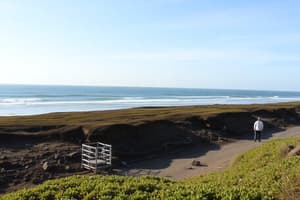Podcast
Questions and Answers
Which of the following best describes the primary role of coastal processes in shaping coastal environments?
Which of the following best describes the primary role of coastal processes in shaping coastal environments?
- Exclusively protecting inland areas from all types of natural disasters.
- Preventing any natural changes to the shoreline.
- Maintaining a static boundary between land and sea.
- Creating dynamic interactions that form and alter coastal landscapes. (correct)
What is the main cause of wave erosion?
What is the main cause of wave erosion?
- The deposition of sediments by ocean currents.
- The gravitational pull of the moon.
- The constant crashing of waves against coastal rocks and sediments. (correct)
- The accumulation of wind-blown sands on the shore.
Which of the following is an example of deposition?
Which of the following is an example of deposition?
- The wearing away of rocks by waves.
- The disruption of sediment flows due to coastal development.
- The transportation of sediments by longshore drift.
- The formation of deltas at river mouths. (correct)
What role do sand dunes play in coastal protection?
What role do sand dunes play in coastal protection?
How does longshore drift contribute to the transportation of sediments?
How does longshore drift contribute to the transportation of sediments?
What is the potential impact of building seawalls and groynes on coastal regions?
What is the potential impact of building seawalls and groynes on coastal regions?
How can dredging activities impact coastal dynamics?
How can dredging activities impact coastal dynamics?
Which of the following best represents a sustainable approach to coastal development?
Which of the following best represents a sustainable approach to coastal development?
Consider a coastal area experiencing increased erosion rates. Which combination of factors would most likely exacerbate this issue, leading to significant coastal land loss?
Consider a coastal area experiencing increased erosion rates. Which combination of factors would most likely exacerbate this issue, leading to significant coastal land loss?
Imagine a coastal region characterized by strong prevailing winds, significant tidal range, and a large river delta. Which of the following scenarios would MOST effectively mitigate the risk of coastal flooding and erosion while promoting biodiversity?
Imagine a coastal region characterized by strong prevailing winds, significant tidal range, and a large river delta. Which of the following scenarios would MOST effectively mitigate the risk of coastal flooding and erosion while promoting biodiversity?
Flashcards
Coastal Processes
Coastal Processes
Dynamic interactions between the ocean and land that shape shorelines and ecosystems.
Coastal Erosion
Coastal Erosion
The wearing away of coastal land by waves, currents, and tides.
Wave Erosion
Wave Erosion
Waves crashing against the shore, gradually wearing away rocks and sediments.
Tidal Erosion
Tidal Erosion
Signup and view all the flashcards
Current-Induced Erosion
Current-Induced Erosion
Signup and view all the flashcards
Coastal Deposition
Coastal Deposition
Signup and view all the flashcards
Sand Dunes
Sand Dunes
Signup and view all the flashcards
Delta Formation
Delta Formation
Signup and view all the flashcards
Longshore Drift
Longshore Drift
Signup and view all the flashcards
Coastal Development Impact
Coastal Development Impact
Signup and view all the flashcards
Study Notes
- Coastal processes involve dynamic interactions between the ocean and land at the shoreline, shaping landscapes and ecosystems.
- Understanding coastal processes aids in coastal management, environmental conservation, and mitigating natural hazards.
Types of Coastal Processes
Erosion
- The process by which coastal land is worn away by waves, currents, ands tides and can lead to loss of beaches and habitats.
- Wave Erosion: Waves crashing against the shore gradually wear away rocks and sediments.
- Tidal Erosion: Tidal movements cause regular submersion and exposure, leading to erosion.
- Currents: Ocean currents transport sediments away from the coast, contributing to erosion.
Deposition
- Deposition occurs when sediments carried by water settle along the coast, forming new landforms.
- Beach Formation: Sand and gravel are deposited by waves.
- Sand Dunes: Wind-blown sands accumulate to form protective dunes.
- Deltas: Rivers deposit sediments at their mouths, creating delta landforms.
Transportation
- Transportation refers to the movement of sediments along the coast.
- Longshore Drift: Sediments are moved along the shore by wave action.
- Sediment Cells: Coastal areas are divided into sediment cells.
Human Impact on Coastal Processes
- Human activities can significantly alter coastal processes.
- Coastal Development: Building on coastlines can disrupt sediment flows and increase erosion.
- Sea Walls and Groynes: Structures built to protect the coast can interfere with natural processes, leading to increased erosion elsewhere.
- Dredging: Removing sediments for navigation or construction can alter coastal dynamics.
Importance of Coastal Processes
- Environmental Protection: Coastal ecosystems and biodiversity are protected.
- Hazard Mitigation: Coastal flooding and erosion risk is being reduced.
- Sustainable Development: Coastal development is environmentally and economically sustainable.
Conclusion
- Coastal processes are complex and integral and studying these processes helps protect and manage coastlines.
Studying That Suits You
Use AI to generate personalized quizzes and flashcards to suit your learning preferences.




